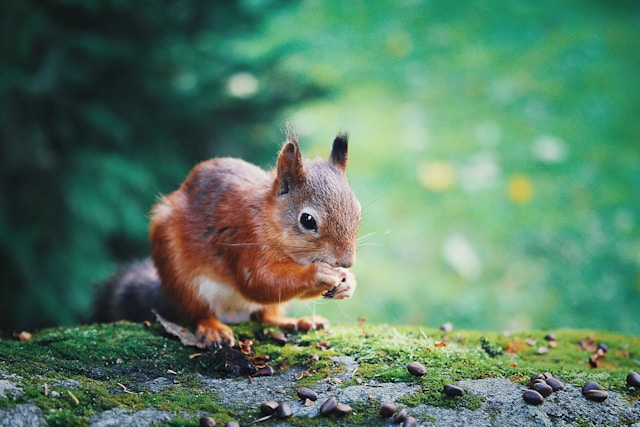A red squirrel was spotted in Bishopbriggs, East Dunbartonshire, marking one of the most southerly sightings in Scotland’s central belt in decades
In a rare and exciting event, a red squirrel was recently spotted darting along a garden fence in Bishopbriggs, East Dunbartonshire, in Scotland’s central belt. The sighting, made by local resident Lanette Perry, has caught the attention of conservationists who see it as a potential sign of success in ongoing efforts to protect and increase the red squirrel population in Scotland.
The red squirrel sighting is particularly notable because it occurred in one of the most southerly locations within the central belt in decades. The sighting was confirmed by Saving Scotland’s Red Squirrels (SSRS), a project led by the Scottish Wildlife Trust, which has been working diligently to protect these native creatures from the threats posed by their non-native grey squirrel counterparts.
Embed from Getty ImagesKatie Berry, a spokeswoman for SSRS, expressed cautious optimism about the sighting. “We cannot say exactly why this pioneering red has turned up in this location,” she said. “However, it is perhaps a testament to the grey squirrel control efforts in areas to the north in recent years and possibly also as a result of increasing pine marten populations in the Central Lowlands.”
The red squirrel, a species native to the UK, has seen its numbers decline drastically in recent decades, with Scotland now home to more than 75% of the UK’s remaining population. Currently, only about 120,000 red squirrels are estimated to remain in Scotland, largely due to competition from the invasive grey squirrel. Introduced from North America in the late 1800s to adorn the gardens of stately homes, grey squirrels have since spread across the country, outcompeting reds for food and habitat.
Grey squirrels also carry squirrel pox, a virus deadly to red squirrels but harmless to themselves, further contributing to the decline of the red squirrel population. Habitat destruction through the loss of woodland areas has compounded these challenges.
Efforts by SSRS, supported by the Scottish government’s Nature Restoration Fund, focus on monitoring squirrel populations, managing the impact of squirrelpox, and controlling the spread of grey squirrels in key areas. The project also investigates the role of pine martens, which are believed to prey more heavily on grey squirrels than on red squirrels, potentially helping to tip the balance in favour of the native species.
While it is too early to determine the full significance of this particular sighting, it provides a glimmer of hope that ongoing conservation efforts may be starting to pay off. The presence of a red squirrel in Bishopbriggs could indicate that the species is beginning to reclaim parts of its former range, a positive sign for the future of Scotland’s red squirrels.
Analysis
Environmental Perspective
The sighting of a red squirrel in Bishopbriggs is a significant event for conservationists working to protect this endangered species. Red squirrels are a vital part of Scotland’s natural heritage, and their decline has been a cause for concern for many years. The ongoing conservation efforts, which include habitat protection, grey squirrel control, and the introduction of pine martens, appear to be making a positive impact. If red squirrels are indeed starting to repopulate areas where they have been absent for decades, it could signal a turning point in the battle to save the species from extinction.
Scientific Perspective
From a scientific standpoint, the red squirrel sighting raises interesting questions about the movement and survival strategies of the species in regions dominated by grey squirrels. The increase in pine marten populations, which prey on grey squirrels, might be creating safer environments for red squirrels, allowing them to venture into areas previously dominated by their invasive relatives. Further research will be necessary to understand the dynamics at play and to ensure that conservation strategies are effectively supporting the red squirrel population.
Cultural Perspective
Red squirrels hold a special place in Scottish culture and are often seen as symbols of the country’s natural beauty. Their decline has been a source of sadness for many, making this sighting in the central belt particularly heartwarming. The possibility of red squirrels returning to areas where they have long been absent resonates with the public’s desire to see native species thrive and ecosystems restored. This sighting serves as a reminder of the importance of ongoing conservation work and the need for continued support for such initiatives.
Economic Perspective
The sighting of a red squirrel in an unexpected location could boost local and national interest in wildlife conservation, potentially leading to increased funding and resources for projects aimed at protecting endangered species. Additionally, as red squirrels are a beloved species, their presence could attract wildlife enthusiasts and tourists, contributing to the local economy through eco-tourism. Ensuring the survival and recovery of the red squirrel population not only benefits the environment but also has the potential to provide economic benefits to communities involved in conservation efforts.
